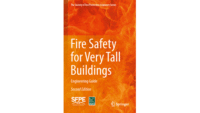
|
| Photo credit: ©istockphoto.com/JimmiLarsen |
Automatic sprinkler systems have been a proven life safety feature since they were first introduced more than 140 years ago.
Today, they are mandated in many new buildings, especially high-rises. The codes provide relief for many requirements when sprinkler systems are installed. These include tradeoffs for passive protection, as well as increased areas and heights among many others. But what role do automatic sprinklers play in high-rise buildings, especially those of the very tall nature?
High-rise buildings can be found around the world. They range in height depending upon the location and the needs of the community. Because of their height, they have the potential of having a high-density population in a relatively small footprint. How do automatic sprinklers apply to these types of structures and what are some of the things that need to be considered when applying design requirements?
The Society of Fire Protection Engineers in conjunction with the International Code Council recently developed an “Engineering Guide for Designing Fire Safety in Very Tall Buildings.” While the guide focuses on all aspects of fire safety, it provides guidance for designers and engineers on issues related to automatic sprinklers in very tall buildings. Written as a guide to be used in conjunction with local codes and standards, it serves as an added tool to those involved in the design, review and construction of automatic sprinklers for very tall buildings.
Fire strategy
The size and nature of very tall buildings poses a unique hazard to the protection of life and property. The height of the building makes it impractical to fight a fire from the outside, forcing emergency response personnel to enter the premises to fight the fire. Occupants of the building likely will not be able to fully evacuate the building, so control of a fire is critical to the overall fire safety feature of a very tall building.
A risk assessment should be performed on the building in order to understand how the risks impact the design and operation of the building’s automatic sprinkler system. From this risk assessment, a strategy for the overall building, including the automatic sprinkler system, can be developed. The strategy should include how reliable the water supply is, whether the exiting strategy will be defend-in-place or full evacuation, whether the sprinkler system should contain the fire or provide enhanced protection because of delayed response times and what the local response capability is for fighting fires in tall buildings.
These strategies may require more emphasis on the sprinkler-system design. The fire strategies need to be developed by persons experienced in the overall aspects of fire and life-safety systems and how they relate to one another.
Reliability
Automatic sprinkler systems can be very reliable when properly designed and maintained. They have a proven track record of controlling fires. Very tall buildings can pose additional constraints on the systems, so additional reliability features should be taken into consideration. These include redundant water supplies, fire pumps and increased water delivery rates.
Automatic sprinklers systems are reliable when they have sufficient water to control or extinguish a fire. The water supply needs to be evaluated to determine if it needs to be augmented. On-site water supply for very tall buildings should be considered since the connections to the municipal water supply may fail or be shut off for maintenance. If the municipal water supply is unreliable, additional on-site water needs should be considered.
Most systems rely on a single connection to the municipal water supply and have risers within the building distributing the water to the various systems. What happens if that municipal source or routing mains within the building fail? Should multiple connections to water mains be included in the design to increase the reliability? For very tall buildings this definitely is something to think about. The designer should also ponder how the distribution within the building can be enhanced to improve reliability. Multiple risers serving systems on floors can improve reliability as well as alternating floor systems from different risers.
Water supply capacity for onsite systems is dependent upon the fire strategies developed. Will the supply be sized to handle just the sprinkler system demands or will other systems, such as standpipes, be served by the system? Most onsite water storage systems are designed for the sprinkler system with limited hose demand. For very tall buildings, the design may need to consider sprinkler system demand and fire department use. The storage tank may need to be increased to accommodate a longer duration of use since the fire strategy may require defend-in-place concepts or expected delayed response from emergency personnel.
Fire pumps
Because of pressure limitations, very tall buildings typically have heights that exceed what a single fire pump is capable of handling. Fire pumps are sized to have output pressures up to 350 psi. Although pumps can be obtained with higher output pressures, the availability of high-pressure pumps are limited and the cost of the pumps, piping and fittings becomes costly in tall buildings. This often requires multiple pumping zones within the building.
For very tall buildings, it is common to see pumps installed in series, with higher zone pumps relying on lower zone pumps to feed them. This requires intermediate pumps to be placed throughout the tower with locations based on the design of the building. The designer or engineer of the system has to be aware of the sprinkler and standpipe zone limitations in order to adequately place pumps within the building.
For reliability purposes, the designer may want to think about multiple pumps for backup purposes, should the primary pumps fail.
Pressure zones
One of the key issues related to high-rise buildings, and therefore very tall buildings, is the limitations placed on standpipe and sprinkler systems because of pressures. Most sprinkler systems are limited in pressure to no more than 175 psi. Very tall buildings will include multiple pressure zones because of the pressure limitations.
Since pressure is needed to boost water up through the building, pressure zones will be created based on the height of the building. In addition, combining risers with sprinkler and standpipe systems impacts the pressure zones since the required hose pressure at the valve outlet is generally high (100 psi) with respect to the sprinkler system requirements.
There are many methods to establish pressure zones within tall buildings. The designer has to consider how to lay out the zones so that required pressures are met for both sprinkler and standpipe systems without exceeding maximum working pressures on either system. One method is to design piping so the pressure is limited on that zone to meet both conditions, often through the use of a single pressure-reducing valve station. This creates a series of sub-risers fed from a high-pressure riser within the building.
Another approach is to use one riser and PRVs at each sprinkler connection or hose valve to limit pressures on the systems. This reduces the amount of piping needed, but introduces far more PRVs.
Another approach to addressing pressure in tall buildings is to use high-pressure piping and equipment on the system. However, many times listed or approved equipment is difficult to find and is costly.
The key to addressing sprinkler systems within very tall buildings is to review the system requirements and coordinate the design with the fire strategies of the building. This takes someone who is familiar with many aspects of fire and life-safety strategies for very tall buildings and someone who understands the relationships between the sprinkler and other fire systems. Experienced designers and engineers are needed to carry out the design and layout of these systems.
Author bio: Allyn J. Vaughn, P.E., is the president of JBA Consulting Engineers in Las Vegas. He has more than 30 years of experience in the fire protection design and consulting industry.


